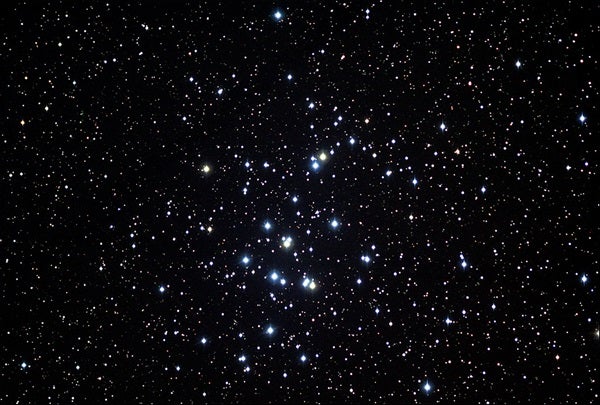Being an astronomical “rookie,” I knew nothing about the early spring constellations. Nevertheless, as my night vision kicked in, I spotted a fuzzy patch of light in a rather barren expanse of sky. It was midway between a pair of bright stars and a large star pattern that formed a backward question mark.
After centering the mystery object in a long metal tube that served as the scope’s finder, I peered into the 80x eyepiece. Seeing nothing, I began a methodical sweep. Suddenly, a brilliant swarm of stars popped into view. The sight was absolutely stunning!
At school the next day, I did a little detective work to identify this dazzling cluster. As I glanced over some star charts, I found one that showed two bright stars (Pollux and Castor in Gemini) and a backward question mark (the “sickle” of Leo) bracketing a rather star-poor area (the constellation Cancer). Imagine my excitement when I saw, plotted in the exact location where I had seen it the night before, my mystery object. I had discovered M44, the Beehive Cluster.
Ancient peoples knew the Beehive as the Praesepe (Latin for “manger”). Around 260 B.C., the Greek poet Aratos referred to it as the “Little Mist.” Its invisibility on an otherwise clear moonless night was considered a precursor of rain — not a bad meteorological forecasting tool, as the light haze that frequently precedes inclement weather will often veil the Praesepe.
The first person to see the Praesepe up close was none other than Galileo Galilei, whose pioneer telescopic exploits we’re celebrating in this International Year of Astronomy. Galileo was the ultimate beginner. No one before him had plied the heavens with a telescope. Everything he saw — craters on the Moon, the phases of Venus, Jupiter’s moons — was new and wondrous.
Various sources put the cluster’s age at about 700 million years.
Modern-day astronomers have added several hundred cluster members to the 40 that Galileo saw. Eighty are brighter than 10th magnitude, including 15 between magnitude 6.3 and 7.5. With an overall magnitude of 3.1, M44 outshines any of Cancer’s stars. Because the Beehive stretches across 1.6° of sky (the width of 3 Full Moons), it begs to be viewed with binoculars or a rich-field telescope. This is one deep-sky object that fares better in small scopes than in refrigerator-sized Dobsonians!
A group of 6th- and 7th-magnitude stars that outline what bears resemblance to a traditional beehive dominates the central part of the Beehive. We can assume the surrounding stars represent a swarm of heavenly bees. The hive’s peak is South 571, an eye-catching triple star that English astronomer Sir James South catalogued in 1825. It’s also known as Burnham 584, after the American double-star observer S.W. Burnham who added a 12th-magnitude star to the mix in 1878.
If you’re an astronomical neophyte, go out tonight and “discover” the Beehive Cluster. As for you veterans who have been around the galaxy awhile, take a break from those 14th-magnitude planetary nebulae! Get out your binoculars or rich-field telescope and spend a few minutes rediscovering this gem. You’re guaranteed to get a cosmic buzz!
My reference to a Gilbert telescope in the opening paragraph might bring back fond memories to some of you old-timers. For a nostalgic look at this classic scope, sold by the A.C. Gilbert Company in the 1950s and 1960s, check out Uncle Rod Mollise’s blog.
Questions, comments, or suggestions? E-mail me at gchaple@hotmail.com. Next month: A peek through Galileo’s telescope. Clear skies!
March 2009: Feast on Saturn
See an archive of Glenn Chaple’s observing basics











